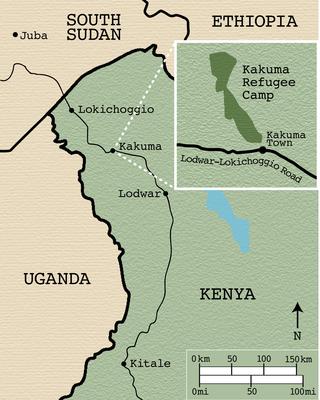PLOS Medicine ( IF 15.8 ) Pub Date : 2020-03-24 , DOI: 10.1371/journal.pmed.1003066 Amber Trujillo Lalla 1, 2 , Katherine Farrell Ginsbach 2 , Naomi Penney 3 , Arsity Shamsudin 4 , Rahul Oka 5

|
Background
According to the United Nations High Commissioner for Refugees, 44,000 people are forced to flee their homes every day due to conflict or persecution. Although refugee camps are designed to provide a safe temporary location for displaced persons, increasing evidence demonstrates that the camps themselves have become stressful and dangerous long-term places—especially for women. However, there is limited literature focused on refugee women’s perspectives on their insecurity. This qualitative study sought to better understand the ways in which women experienced insecurity at a refugee camp in Kenya.
Methods and findings
Between May 2017 and June 2017, ethnographic semi-structured interviews accompanied by observation were conducted with a snowball sampling of 20 Somali (n = 10) and Ethiopian Oromo (n = 10) women, 18 years and older, who had had at least 1 pregnancy while living in Kakuma Refugee Camp. The interviews were orally translated, transcribed, entered into Dedoose software for coding, and analyzed utilizing an ethnographic approach. Four sources of insecurity became evident: tension between refugees and the host community, intra- or intercultural conflicts, direct abuse and/or neglect by camp staff and security personnel, and unsafe situations in accessing healthcare–both in traveling to healthcare facilities and in the facilities themselves. Potential limitations include nonrandom sampling, the focus on a specific population, the inability to record interviews, and possible subtle errors in translation.
Conclusions
In this study, we observed that women felt insecure in almost every area of the camp, with there being no place in the camp where the women felt safe. As it is well documented that insecure and stressful settings may have deleterious effects on health, understanding the sources of insecurity for women in refugee camps can help to guide services for healthcare in displaced settings. By creating a safer environment for these women in private, in public, and in the process of accessing care in refugee camps, we can improve health for them and their babies.
中文翻译:

对在卡库马难民营分娩的埃塞俄比亚奥罗莫妇女和索马里妇女的不安全感进行探究:定性研究。
背景
联合国难民事务高级专员说,由于冲突或迫害,每天有44,000人被迫逃离家园。尽管难民营的设计目的是为流离失所者提供一个安全的临时场所,但越来越多的证据表明,难民营本身已成为压力很大且危险的长期场所,尤其是对妇女而言。但是,关于难民妇女对她们的不安全感的观点的文献很少。这项定性研究试图更好地了解妇女在肯尼亚的难民营中经历不安全感的方式。
方法和发现
在2017年5月至2017年6月之间,进行了人种学半结构化访谈并进行了观察,并进行了20个索马里人(n = 10)和埃塞俄比亚奥罗莫人(n =10)18岁及以上的妇女,在卡库马难民营中至少怀孕1次。采访被口头翻译,转录,输入Dedoose软件进行编码,并使用人种学方法进行分析。不安全的四个根源变得显而易见:难民与收容社区之间的紧张局势,文化间或文化间的冲突,营地工作人员和安全人员的直接虐待和/或忽视,以及在获得医疗保健方面的不安全状况,包括前往医疗机构和设施本身。潜在的局限性包括非随机抽样,关注特定人群,无法记录采访内容以及翻译中可能存在的细微错误。
结论
在这项研究中,我们观察到营地中几乎每个区域的妇女都感到不安全,营地中没有地方让女性感到安全。有充分的资料表明,不安全和压力大的环境可能对健康产生有害影响,因此了解难民营中妇女的不安全感根源可以帮助指导流离失所环境中的医疗服务。通过在私人,公共场所以及在难民营中获得照料的过程中为这些妇女创造更安全的环境,我们可以改善她们及其婴儿的健康。



























 京公网安备 11010802027423号
京公网安备 11010802027423号